Authentic Polish Pierogi with Potatoes and Cheese (Pierogi Ruskie)
This post may contain affiliate links which won’t change your price but will share some commission.
These Authentic Polish Pierogi with Potatoes and Cheese (Pierogi Ruskie) are the real deal. Traditional Polish dish at its best! Try this recipe and never buy pierogi again. They are amazing.
This post was originally published on December 24, 2014 (On Christmas Eve!) and since then has been updated to provide additional information.
You can also learn how to make Sauerkraut and Mushroom Pierogi from Scratch here or if you prefer a more creative version of pierogi try these Roasted Butternut Squash and Feta Pierogi.
This post may contain affiliate links. You can read my disclosure policy HERE.
Polish Pierogi with Potatoes and Cheese (Pierogi Ruskie) – the Most Popular Kind
Have you ever tried real, authentic Polish pierogi?
Now I’m not talking about the frozen dish that you can purchase in almost every supermarket. In fact, these store-bought cousins are even improperly named. They’re called “Pierogies.”
For all Poles, this is the funniest thing ever. The reason being is that the word “Pierogi” is already pluralized (1 “pierog” is the singular). The addition of an “s” to make the English name plural is just way too funny. But obviously, I get it, and I’m absolutely not offended.
Actually, it makes me proud that we have created a dish so popular that is eaten throughout the world. So, if you haven’t tried a truly authentic version yet, then definitely give these a go. ‘Street-cred’ affirmation: I am 100% Polish, born and raised in Wroclaw, Poland, and I make pierogi every year. These are the real deal :)
Authentic Polish Pierogi Served on Christmas Eve
As I mentioned I make this type of Authentic Polish Pierogi every year….for Christmas. However, these aren’t the only variety out there; I also make pierogi with sauerkraut and mushrooms – which are far more typical for Christmas in Polish homes.
Yet, Pierogi with Potatoes and Cheese (Pierogi Ruskie) are also very popular and often cooked in Polish homes. So, long story short, I brought this culinary tradition with me to the US and every year I devote either a day or 2 to making my favorite Polish dishes for Christmas.
In an effort to perpetuate these traditions, I’ve been indoctrinating my new family (my husband and my in-laws) by annually hosting a Christmas Eve dinner. And while this effort to cultivate their palates to the full spectrum of my Polish Christmas menu at first was met with baby steps, I can honestly say that they’re all in full stride now.
Staples of this Christmas menu include:
- 2 kinds of pierogi (with potatoes and cheese and with sauerkraut and mushrooms),
- Red borsch (a clear beet soup) with uszka (ear pierogi),
- Bigos ( Polish Hunter’s stew) or Kapusta (Sauerkraut with Mushrooms),
- fish “Greek style” (funny that it’s dubbed ‘Greek’ because it’s a very Polish dish), and
- Salatka (a root vegetable/potato/egg salad to die for, also known as Russian Salad) or Polish Potato and Egg Salad with Pickles.
While I could do more, I’ve decided to limit it and still enjoy the process of cooking and sharing with my family.
Now that we have Gabe and Aiden, who are growing up way too fast (sorry for the cliche gang, but it’s true), who are half Polish, I really want them to experience some of Mommy’s, and therefore their own, traditions. So I try to supplement their diet with Polish dishes whenever I can. My older one really loves Polish Dill Pickle Soup!
Polish Christmas Traditions
As long as I’m talking about traditions I’d like to give you a little glimpse of how a Polish Christmas looked for me when I was growing up. Obviously, I’m saying “for me” because I know that almost every home had its own little differences.
In fact, I know that as some of my Polish friends read this post they’ll be saying that this or that looked different in their houses. For instance, there was a clear divide between the soup served. I’m aware that people either had borsch (my house) or mushroom soup. With that said, there were some hybrid houses that had both soups served.
And recently I found out that there was yet another type of soup gracing Christmas tables…sauerkraut and mushroom. These variations seemed to run with geographic regions (like Red & Blue states). So, as this one example attests, different parts of Poland had different traditions; but I can tell you that there were some universals for all Poles.
Christmas Eve dinner always kicked off the holidays. Dinner was served after the first star showed up in the sky and consisted of 12 dishes. However, atypical of most Polish meals, meat was prohibited from the Christmas Eve table. Rather, the ingredients which dominated tables were: fish, pierogi, mushrooms, sauerkraut, and cabbage.
The common dishes served on Christmas Eve would be:
- borsch with mushroom mini pierogi (kind of like a ravioli), mushroom soup,
- different varieties of pierogi (the most popular being with mushrooms and sauerkraut and pierogi ruskie),
- bigos without meat (hunter’s stew – sauerkraut with mushrooms, plums, tomatoes) or just sauerkraut with mushrooms,
- fish – Hearings served in different sauces, and the most popular being Karp. My family wasn’t a huge fan of Karp because it was so boney and therefore my mom always went with Trout. Our go-to was a whole trout stuffed with lemon and butter (OMG!).
I don’t know if you’re familiar with our Polish Karp tradition, but it seems to me that a number of people around the world have a vague familiarity with it, as I was asked about it a few times.
Anyhow if were to visit any community in Poland right before Christmas, you would find places everywhere selling “Live Karp.” As a kid, my own appreciation of this was that everyone was taking Karps home and letting them swim in the tub (cool right? a pet!). I knew nothing more than that. To this day I still question where these glorious pets would vanish to.
How to make Polish Pierogi Ruskie
But I digress, Pierogi are a different story. I always know where they start, and where they end. They start with potatoes, cheese, onions, spices, and with flour for the dough. I roll it, cut it into little round cutouts, insert a little ball of potatoes/cheese mixture, seal it, and there you go.
But let’s take it one step at a time (for exact measurements, instructions and nutritional information scroll down to a printable recipe):
Prepare the pierogi ruskie filling:
Step 1; Boil your starchy potatoes (medium yellow potatoes or russet potatoes) with salted water; drain, and mash either using a potato ricer or potato masher;
Step 2: In a frying pan, heat up some butter, oil, or ghee and fry up onions until almost brown (they will add a ton of flavor to the filling;
Step 3: Add framer cheese into the potatoes and mix well;
Step 4: Add fried onions, other cheeses, and spices to the potatoes/cheese mixture and mix well. Set the filling aside (The addition of blue cheese and cheddar is something new to me. It’s a simple trick from a very famous Polish chef. I tried it and it really elevates this dish to another level).
Prepare the pierogi dough:
Step 1: Pour the flour on a counter or other surface that will allow you to make the dough, add a pinch of salt, make a little hole in the middle and start adding milk and butter, add a little water at a time and work the dough until you can form a ball about 10-15 minutes; (Some people use egg for the dough. I tried all kinds of dough variations and in my opinion, mine is the most delicate. Egg tends to make the dough tougher. You can add an egg to the dough and reduce the amount of liquid).
Step 2: Once done, cover it with the big bowl and let it rest for about 20-30 minutes
Step 3: Roll the dough until thin (like pasta) and using either a cookie cutter or a large wine glass cut the circles; place 1 teaspoon of the fling in the middle of the circle, wet one half of the circle, and then seal it together;
Step 4: Boil a large pot of water and season with salt; once the water is boiling put about 8 pierogi at a time; once they come to the surface let them cook for 1 minute and using a spider or slotted spoon take them out on a plate;
Step 5: OPTIONAL: If you want to fry them as I did here, use 1 tablespoon of oil or ghee and fry pierogi on each side until golden brown. It’s best to dry them first before frying so they don’t splash.
For the pierogi toppings:
While this tradition mentioned above is alive, I no longer abide by the “no meat” on Christmas Eve mandate. So, often I sprinkle my pierogi with a little bit of chopped bacon, and likewise, I use sausage in my hunter’s stew. But I know that a lot of people are still very strict about this requirement.
Anyhow, the addition of meat is purely optional. For the featured version here of Authentic Polish pierogi, I did go with some chopped bacon.
-
Using separate pans add oil and onions and fry the onions until golden brown and bacon until crispy (you don’t need fat for bacon as it is already fatty);
-
Add onions and bacon on top of the pierogi and serve with sour cream.
Storing and freezing pierogi
If you are not serving pierogi immediately, take them out on a counter and let them cool down and dry a little bit. Make sure that they are not touching each other.
Once cooled, place them on a baking sheet, again at distance from each other, place them in a freezer and let them freeze. Once done, you can pack them in a plastic bag.
Now, I won’t lie here. When you’re new to the Pierogi-making business it can take a while to master them. Admittedly, they seem so easy, but when you get to the point where they have to be sealed, a lot of times you’ll find that they aren’t very cooperative. But practice makes perfect. It used to take me hours from start to finish.
Now I can be done in 2 hours with about 80 Pierogi – ready to serve. So, if you have the patience to learn how to make them, then go ahead and give them a try. Just don’t get discouraged the first time out. Even if it takes time, I can guarantee that they will taste delicious and you’ll be so proud of yourself that you will want to tell the whole world about them and the work you’ve done.
How to Alter this Recipe for Authentic Polish Pierogi:
- As mentioned above you can add an egg to your dough.
- I usually have no problem finding farmer cheese in local supermarkets in N.Y. but I know that it may be difficult to find. You can either buy Framer cheese on Amazon or use whole milk large curd cottage cheese (about 8 oz. but be careful because this cheese is more watery so your filling may become a little too soft);
- I added a little cheddar and blue cheese but they can be omitted;
- They can be served boiled or fried with just fried onions.
If you’re looking for more Polish recipes here are a couple of suggestions:
- Dill Pickle Soup – Traditional Polish Recipe
- Pierogi with Sauerkraut and Mushrooms from scratch:
- Kapusta – Sauerkraut with Mushrooms
- Cabbage and Kielbasa
- Bigos – Polish Hunter Stew
- Roasted Butternut Squash Feta Pierogi
- Polish Cucumber Salad – Mizeria
- Polish Fluffy Apple Pancakes
- Breton Beans (Fasolka po Bretonsku)
- Creamy Mushroom Sauce
I guess I’ve waited a lifetime to say, ‘hey world, here are Pierogi!!!!’ Without further adieu, I give you my super delicious Authentic Polish Pierogi with Potatoes and Cheese. Cheers!
And if you want to finish your dinner with some delicious treats, these Traditional Czech Linzer Cookies will be your new favourite.

Authentic Polish Pierogi with Potatoes and Cheese Recipe
Ingredients
For the filling:
- 5 Potatoes yellow, medium or 3 large russet potatoes
- 8 oz Farmer cheese
- 1 tablespoon Blue cheese (optional)
- 2 tablespoon Cheddar cheese (optional)
- 1 Onion sweet, yellow, large, chopped
- 1/2 teaspoon Garlic powder
- 1/2 teaspoon Onion powder
- 1 tablespoon Oil or ghee for onion
- Kosher salt and freshly ground black pepper to taste
For the dough:
- 3 cups Whole purpose flour
- 1/2 cup Milk 2%, warm
- 1/2 to 3/4 cup Warm water (depending on how much your flour soaks)
- 1 tablespoon Butter melted, unsalted
- A little bit of kosher salt
For the toppings
- 1 Onion large, yellow, chopped
- 3 slabs Bacon chopped (optional)
- 1/2 cup Sour cream
- 2 tablespoon Oil or ghee for frying
Instructions
For the filling:
- Place potatoes in a pot, cover with water and cook until fork tender;
- In the meantime heat up the oil or ghee in a frying pan, add onions, and cook until golden brown;
- Once potatoes are cooked, using a potato ricer or potato masher, mashed potatoes so they don't have lumps;
- Add farmer cheese and mix together;
- Add onions, other cheeses, spices, salt, and pepper and mix well.
For the dough:
- Pour the flour on a counter or other surface that will allow you to make the dough;
- Add a pinch of salt;
- Make a little hole in the middle and start adding milk and butter;
- Add a little water at a time and work the dough until you can form a ball about 10-15 minutes;
- Once done, cover it with the big bowl and let it rest for about 20-30 minutes;
- Roll the dough until thin (like pasta) and using either a cookie cutter or a large wine glass cut the circles;
- Place 1 teaspoon of the filling in the middle of the circle;
- Wet one half of the circle and then seal it together;
- Boil a large pot of water and season with salt;
- Once the water is boiling put about 8 pierogi at a time;
- Once they come to the surface let them cook for 1 minute and using a spider or slotted spoon take them out on a plate;
- If you want to fry them as I did here, use 1 tablespoon of oil or ghee and fry pierogi on each side until golden brown;
For the toppings:
- Using separate pans add oil and onions and fry the onions until golden brown and bacon until crispy (you don't need fat for bacon as it is already fatty);
- Add onions and bacon on top of the pierogi and serve with sour cream.
Notes
2. Addition of blue cheese and cheddar is something new to me. It's a simple trick from a very famous Polish chef. I tried it and it really elevates this dish to another level.
3. If you are not serving pierogi immediately, take them out on a counter and let them cool down and dry a little bit. Make sure that they are not touching each other. Once cooled, place them on a baking sheet, again at distance from each other, place in a freezer, and let them freeze. Once done, you can pack them in a plastic bag.
Nutrition
PIN IT for later:
Read about the author Edyta here or follow Eating European on social media: Facebook, Instagram, Pinterest, and Twitter.





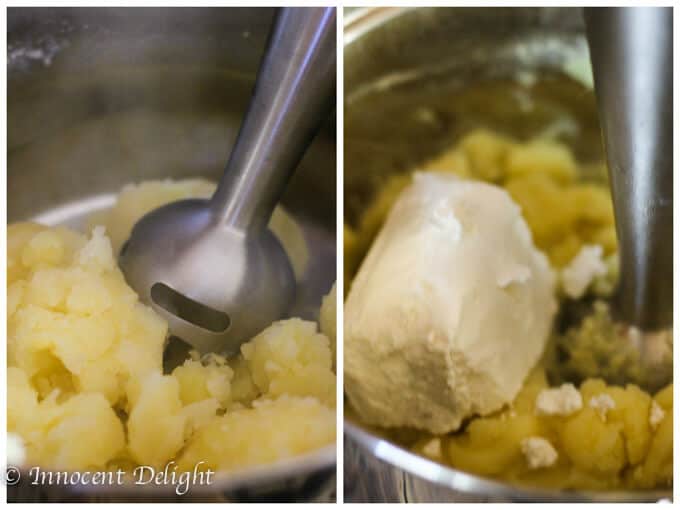

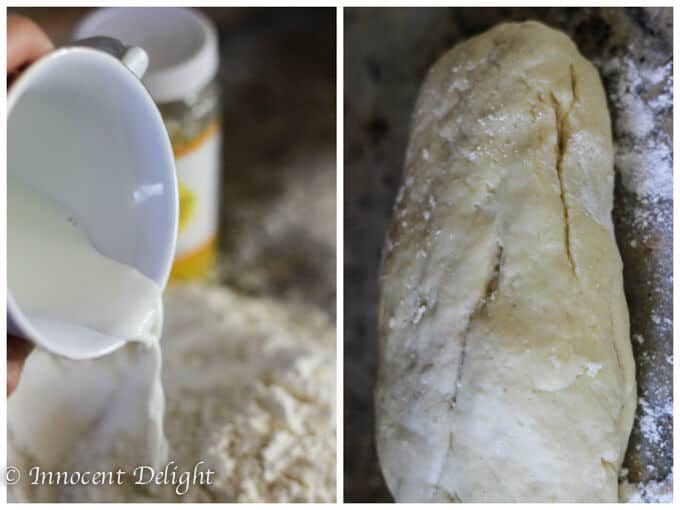
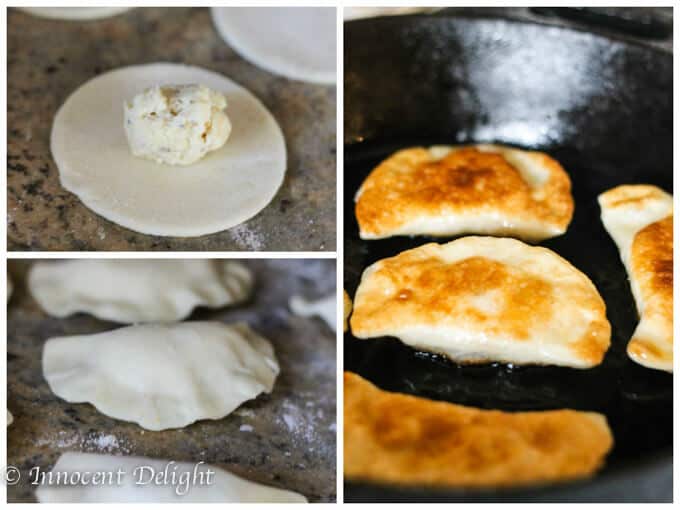


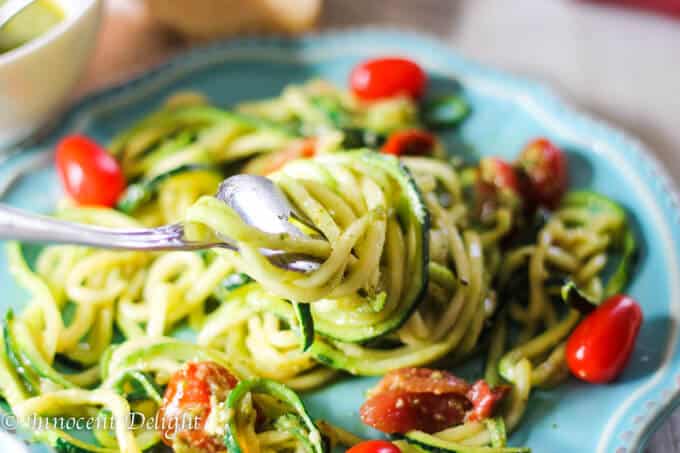


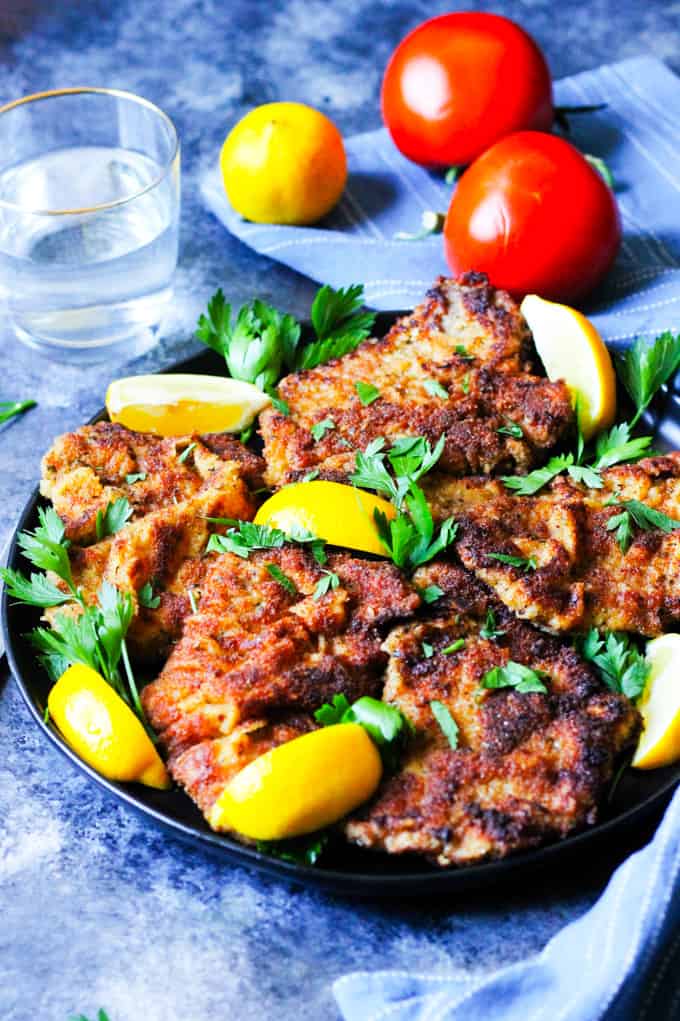

I’m so excited about trying this recipe. We adore the frozen, store-bought pierogi, so I am salivating at the thought of having authentic, home-cooked ones. 😀 I do have a question: could these be prepared ahead of time and either refrigerated or frozen for busy weeks when cooking time is limited? Thanks!
Hi Laura, yes you can prepare them ahead of time. You need to be careful though because the dough can stick together. If you want to make them and keep them in a fridge for a couple of days, the best thing is to melt some butter and pour it over warm pierogi, gently stir it so all of them are covered with butter. It will keep them from sticking together. If you want to freeze them, the best way is to cook them first and and when you took them out of the water, place them on a baking sheet apart from each other and let dry. Once the top is dry, using another baking sheet, flip the pierogi and put them on a new, dry baking sheet to dry them on the other side. After they are dry, place the whole baking sheet into the freezer. Let them freeze totally for couple of hours and once they are frozen, you can move them to a plastic bag and store for a few months. Good luck and let me know if you have any more questions. 🙂
Hello, thanks so much for sharing this recipe. If I want to fry them, is that done after boiling them to brown them or does all of the cooking take place in the frying pan?
Hi Michael. You need to boil the pierogi first. If you want to fry them afterwords you will need to make sure that they are dry so they don’t splash on a pan.
Please tell me whatbis farmers cheese? Cream cheese maybe ?
It is a white cheese, usually sold in blocks and it actually is called Farmer’s Cheese. You should ask in your local grocery store.Thanks for stopping by Anita.
Thanks for sharing your recipe. Looking forward to trying it. Can the dough be made in a mixer?
I’m not sure. I don’t have mixer so I have never tried yet. If you do, let me know how did it come out. Thanks Tina
I was wondering the same thing Edyta, would love to know if I can use my mixer
By all means, use the mixer and let me know how it came out. I don’t have one and I cannot really say for sure, but I know that people are making dough in the mixers and it comes out great. Less work for you 🙂 Worth a try Phillis!
Made these tonight and they were just right! So glad I didn’t use an egg dough. thanks!
Great, thanks Jennifer. I found that adding an egg makes the dough tougher.
Do you have a better measurement for the farmers cheese? My package is 7.4 oz …not
Sure how I’m Supposed to figure out 0.8 oz. and only 2 tablespoons of cheddar…it doesn’t seem like very much cheese for the recipe
I am so sorry Kim. I made a typo in there. It should be 8 oz. so if you have a package 7.4 that will be enough.
Thank you! 🙂
Also, do you either boil OR fry them? Is it one or the other? Of if you have any to fry them are they boiled first then fried?
Boil them first and then you can either eat them just boiled or you can fry them up for crispy outside.
Great, thanks! 😊
If I am planning to prepare these for a future event, is it better to freeze after boiling or freeze after the frying?
Hi Bethany. Cook pierogi until they just come to the surface. Take them out and place either on baking sheets or directly on your clean countertop separately. Make sure that they don’t touch each other. They will dry on top, then flip them on the dry surface and dry them out on the other side. The whole process is to make sure that they do not stick together. Then place them separately on the baking sheet and put it in a freezer. After couple of hours you can take the sheet out and put pierogi in either plastic bag or container and put them back to the freezer. When you need to use them, simply put frozen pierogi to the hot, boiling water. Let them come to the surface and cook for a minute or two. Take them out and either serve like this with some onions and bacon (just make sure that they are covered with some fat so they will not be sticking) or now you can fry them. It’s best to dry them a little bit before you fry them so they will not be making splashes on a pan. Let me know if you have any more questions.
I am so excited to find your blog and make this recipe! My first late husband was of polish ancestry- his grandmother in Pennsylvania made the first Pierogi I ever tasted- I have never had one since that came close…. this isn’t very common recipe in the southern state I live in ☺
I used to binge eat the frozen perogi back in college as a snack. Yes, I was overweight. But they were always super bland. So I just assumed that I would have to tolerate the blandness. I am a quarter Polish and have never had authentic Perogi. I’m so going to make these and freeze them for when I need a bit of nostalgia but with flavor of epic proportions. I would do bacon too. Why do many Polish families refrain from eating meat on Christmas eve? As a Catholic growing up, we only did that on Fridays and Ash Wednesday all during Lent.
Hi Kendall, I don’t think that it was Polish thing to not eat meat on Fridays. I know that Italians are doing that too. I also know that recently Pop said that you don’t have to refrain from eating meat on Christmas Eve but because it has always being a tradition, most Poles still don’t eat meat on this day.
Can you let the dough sit over night?
Hi Jennifer. To be quite honest I have never let the dough sit that long. I know that some people freeze the dough but I am not sure how it works after that. It doesn’t take much time so I prefer to prepare fresh one. Few hours would be fine but I’m not sure about overnight.
This looks so absolutely delicious and reminds me of my grandma’s house when I was little. I can’t wait to make these!
Thank you Christy!
Thanks for sharing the recipe with step by step pictures. I am soon going to try this.
Great, let me know how you liked it.
Yes I made it yesterday. Amazing taste!
Awesome! It makes me super happy!
misplaced my matka’s mamusia recipe n was ready to make found urs wow ur website photos n detailed explanation was GREAT BEST EVER EZ TO FOLLOW THANK U SO MUCH LOVED LOVED UR SITE !! & got such a kick out of ur notes/blog.im an immigrant LEGALLY ! ashamed to say havent made in several yrs since parents died but finally craved to make again for my grdkids thx for taking me back….PLZ KEEP OUR POLISH RECIPES COMING/POSTED will be checking em all n trying again to connect to my my heritage bless u Zosia
Thank you so much Zosia! You just made my day. Please come back to my blog often. I will make sure to post more Polish recipes 🙂
Hi! I’m interested in making these; however, being from a fairly small town in the southern region of Georgia (USA), I can not seem to find farmer’s cheese anywhere. I’ve asked several grocery stores around town (including a neighboring, larger town), and no one seems to carry it. Is there anything I can substitute? Thank you!
You can try getting it online (Amazon) or if you cannot get it you can try with cottage cheese. However cottage cheese is way more watery so I am not sure how it will come out and what proportions you should use. I’d say add some to the potatoes and taste how you like it. If you feel like you should add more, do it. But again, I cannot really guarantee that the effect will be close to what it should be. Thanks for checking my recipe Crystal and I am so sorry that you cannot easily get the farmers cheese around you. That’s a bummer 🙁
Strain the cottage cheese first so it is a little dryer
My gramma would squeeze the water from cottage cheese with a very heavy rock. The cheese was in cheese cloth and just dripped into a plate. Never, never use that rock!!!
I would love to purchase the plain cheese or the cabbage perogi because my husband is 1/2 Polish and his Grandmother always made those two and gave us some – the authentic perogi is Wonderful but the store-bought are nasty!
I know that store bought are not good. Why don’t you try making them 🙂
HI Edyta! I made these pierogi last weekend and they are delicious! I will definitely be making them again. For anyone wanting to know about making these in a mixer, I used my stand mixer with the dough hook and added the water in stages until the dough formed a ball. I then kneaded it by hand for a few seconds and left on my counter covered with the mixing bowl. I couldn’t find farmers cheese at my local cheese shop so I substituted whole milk large curd cottage cheese. I didn’t measure it, but I probably used between 6 and 8 oz. I did use a pasta maker to roll the dough instead of rolling by hand. I am sure that isn’t traditional, but it made light work of rolling the dough! I froze most of the pierogi according to your directions and they turned out great! I did fry them from frozen instead of boiling first (read your tip after I already fried a few batches). If you have only tried the frozen store bought ones and think you don’t like pierogi, try these! Thank you for sharing your recipe:-)
Thank you so much Tiffany! That’s very helpful for my readers. I really appreciate that you took time to provide this information. I just got stand up mixer and will definitely use it next time I will make pierogi 🙂
Oh my gosh! Thank you for this recipe. The dough was easy to work with!
I have just made 60 for my party on Saturday. I did cook one for lunch as a taste test. I am so happy with my finished product. I will never buy a frozen pierogi again.
Btw. I didn’t find farmers cheese but a recommended substitute is Queso and is readily available in the Pacific NW.
Judy
Great idea with Queso Judy. I’m glad you liked them 🙂
Another note was I usd a potato ricer to make them very fine and fluffy. I had leftover potato mixture and they are in the frying pan as potato cakes for dinner with the roast. Great recipe! Thanks again.
Hi, I just tried your pierogi recipe today and they turned out so well! Thank you for your easy to follow instructions! I was wondering though how many this recipe is supposed to make typically? I liked the thickness of my rolled dough, but was unsure if maybe it didn’t make as many and should be thinner. (I got 28 out of it)
Thanks for your time!
Hi Calleigh. Thank you so much for trying my recipe. I usually try to get my dough pretty thin and I can get about 35-40 pierogi from this recipe. But for sure the thicker the dough the easier it is to make them. So there is a little trade of. Try make the dough thiner next time and see what you prefer 🙂
Hi,
So I’ve been wanting to make these for a while, but I live way in outback Australia, and the cheese selection is pretty pathetic so I know that farmer’s cheese is not something I will find here. Is there any kind of substitute that would work? Thanks!
Hi Edyta,
I just noticed in one of the previous comments you said to use cottage cheese. What if I put the cottage cheese in cheese cloth to let some of the moisture strain out, do you think that would help to keep the mixture drier?
Thanks again 🙂
Yes Teera-Lee, for sure. You can do this. Use a cottage cheese and strain it and it will resemble the farmers cheese. Let me know how it came out 🙂
I am one of the very fortunate “in-laws” that has benefited from Edyta’s Christmas feast and will attest to the fact that I never really knew what a true perogi should be — and her bigos are scrumptous! I’m looking forward to another Polish traditional meal with the family!!!
FYI I found Farmers cheese at our local Amish Bulk Food Store.
Fantastic! Let me know how your pierogi come out 🙂
Sorry honey, Pirogi were not created by the Poles. They are Ukrainian. Pierogi, or more properly varenyky were brought to Poland from Kiev by Saint Hyacinth in the 13th century. Anyhow, I enjoyed reading about your family traditions. I tried following my mothers recipe but they come out tough and chewy while my mother’s would just about melt in my mouth. People told me if you work the dough too long it brings out the gluten and makes them tough. I tried to not fuss with the dough too much but it didn’t seem to help. Once I even tried to make them with cake flour thinking that cake flour did not have much gluten. Any suggestions would be appreciated
Hey there, thanks for your comment. If what you say holds true about the origin of pierogi they were in Poland for about 800 years and developed a regional uniqueness. This recipe is my family recipe and I make it all the time. The dough never is tough or chewy because I don’t use an egg. However, if you’re looking for a recipe for varenyky I’ve seen a couple of good recipes so you probably should look for that. The technique to make the dough is totally different than for pierogi. Good luck.
Csnt wait too make these i have so many different kinds my mom was polish and have hers but you know it allin your head by looks so now maybe this will work for me thank you
So I know this recipe has been up for a while, but I wanted to put my thoughts. Super delicious – I made the farmer’s cheese from scratch cuz I didn’t want one that was so heavily salted as the store-bought stuff. I added chives to the farmer’s cheese, green onions to the potatoes, and I cooked the potatoes in cream with garlic sous vide 195/1.5 hours. Super great.
I made the dough in my mixer, came out great. Kneaded for 7 minutes with the hook, then wrapped it and let sit for an hour. These will be a very nice treat for a friend who immigrated from Poland a year ago and hasn’t had good pierogi since. Thanks!
Thanks for all your feedback and suggestions 🙂